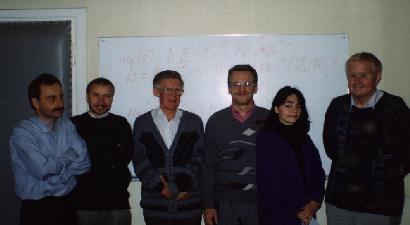This research involves the development of sophisticated computational tools to exploit the use of symmetry principles in describing a wide range of properties of physical systems. Applications are being made to diverse topics including the spectroscopic properties of lanthanides and actinides, quantum dots, hyperfine structure. Considerable attention is also directed at a range of combinatorial problems related to properties of Lie groups and symmetric functions. There is active collaboration with University of Western Illinois (Prof. M. Yang), University of Southampton (Prof. R. C. King), Universität Bayreuth (Dr. T. Scharf) and Université de Marne-la-Vallée (Dr. J-Y Thibon).
These studies are aimed at understanding the structure and properties of many-fermion and many-boson finite-dimensional model spaces. The results are applied to matrix element evaluation, deriving expressions for moments of spectral density distributions, studying statistical properties of spectra, determining envelopes of molecular vibronic bands and developing the theory of reduced hamiltonians. Cooperation involves Departament de Ciències Experimentals, Universitat Jaume I, Castelló (Josep Planelles), Consejo Superior de Investigaciones Cientificas (CSIC), Madrid (Carmela Valdemoro), Divisió de Química, Universitat de Girona, (Ramón Carbó), Universidad de la Republica, Montevideo (Oscar Ventura), Institute of Physics, Poznan Polytechnic (Malgorzata Bancewicz).
The work is aimed at both developing new methods and studying properties of specific systems. The systems studied include small diatomic molecules, Rydberg molecules, and excited states of weakly bound systems. The implementations range from very accurate calculations (as relativity-correlation cross term effects) to semiempirical ones (relativistic formulation of the quantum defect orbital method). Cooperation involves Max-Planck-Institut für Astrophysik, Garching bei München (Geerd H. F. Diercksen), Institute of Chemistry, University of Katowice (Maria Barysz), Institute of Physics, Szczecin University (Jacek Styszynski), Departamento de Química Física, Universidad de Valladolid (Inmaculada Martin), Laboratoire de Physique Quantique, Université Paul Sabatier, Toulouse (Philippe Durand).
Methods of describing the electronic structure of 2D electron gas and impurity atoms in semiconductor quantum wells and on surfaces are being developed. The resonant states and transport properties through the multibarrier structures, including applied electric field, are also investigated. This subject is being developed in cooperation with Instituto de Ciencias Materiales, CSIC, Madrid (F. García-Moliner, V. Velasco and L. Chico).
Methods of describing the electronic structure of atoms and molecules inside zeolite-type cavities and channels are being developed. Using model potentials, the systems investigated include also 0D electron gas and impurity atoms confined in quantum dots. The electron correlation in spatially confined systems is also studied. Cooperation involves Departament de Ciències Experimentals, Universitat Jaume I, Castelló (J. Planelles) and Instituto de Tecnologia Quimica CSIC, Valencia (C. Zicovich-Wilson and A. Corma).
Quantum radiation of atoms near dielectric and metallic media is studied. Both, planar and cavity-type interfaces are investigated. A perturbative approach for the Heisenberg equation of motion is being developed. The research goes on in collaboration with Institudo de Fisica, Universidade Federal de Rio de Janeiro (L. Davidivich).
Theoretical methods of description of autoionizing resonances in atoms are being developed. Spectra of light atoms and ions (especially the negative ions) are searched for resonant states. An influence of the magnetic field on properties of resonances is also studied. The research goes on in cooperation with the Theoretical and Physical Chemistry Institute of the National Hellenic Research Foundation in Athens (Cleanthes A. Nicolaides).
Efficient algorithms for solving numerically Hartree-Fock and Dirac-Fock equations for molecules are being developed. The study is aimed at determining accurate universal Gaussian basis sets for molecular calculations. The systems studied include heavy diatomic molecules. Cooperation involves Supercomputer Computations Research Institute, Florida State University, Tallahasses, U.S.A (D. Moncrieff) and Rutherford Appleton Laboratory, Chilton, Oxon, UK (S. Wilson).
Papers

